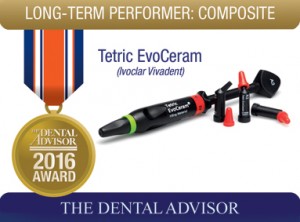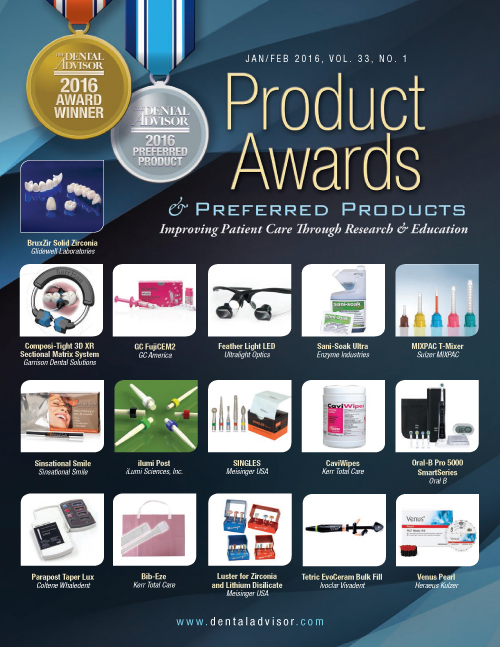Clinical Evaluations
Tetric EvoCeram (8 yr)
Consultants’ Comments
- “Definitely my favorite material when it comes to handling and shaping posterior composites.”
- “Retains esthetics and polish over time.”
- “Amazing resistance to wear even after eight years.”
- “Best handling posterior composite.”
Description
Tetric EvoCeram is a universal, hybrid composite indicated for anterior and posterior esthetic restorations. The composite is radiopaque and formulated to meet any rigorous esthetic challenge with availability in Enamel, Dentin, and bleach shades. This light-cured composite consists of particles ranging in size from 40 to 3000 nm with an average particle size of about 550 nm. It is packaged in 0.2 g, color-coded, unit-dose capsules and 3 g color-coded syringes.
Clinical Evaluation Protocol
- 873 restorations were placed and monitored over an eight-year period.
- 637 (73%) of these restorations were recalled over a six-month period. The restorations included both anterior and posterior teeth (Figure 1).
- The recalled restorations were Classes I, II, and Class IV composites (Figure 2).
- Timeline of restorations in clinical service is shown in Figure 3.
- At recall the following categories, esthetics, resistance to fracture/chipping, resistance to marginal discoloration, and wear resistance were rated on a scale of 1 to 5 with 1=poor, 2=fair, 3=good, 4=very good, 5=excellent. Any restoration receiving a rating of 1 or a 2 in a category is automatically replaced. Restorations receiving a rating of 3 or 4 in a category are still clinically acceptable and are not replaced.
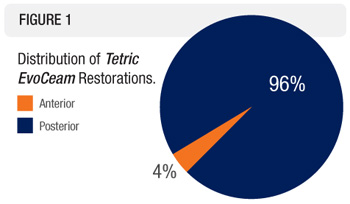
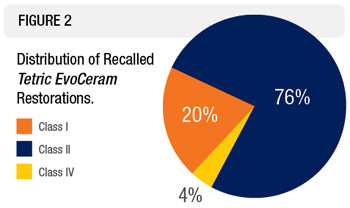
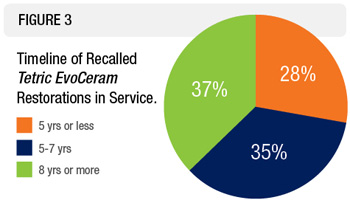
Clinical Observations
Esthetics
The esthetics of Tetric EvoCeram was excellent at recall (Figure 4). Out of 637 recalled restorations, 93% received an excellent rating and 7% received good to very good rating and did not require replacement. Only three restorations (0.5%) required replacement because of poor esthetics. Tetric EvoCeram layered with a translucent shade often resulted in improved esthetics, opalescence and translucency. Layering is especially important in teeth that are discolored.
Resistance to Fracture and Chipping
Over 95% of the 637 recalled Tetric EvoCeram restorations received an excellent rating (Figure 4). 2% of the restorations had chipped but did not require replacement, while 3% or 19 restorations did need to be replaced. Tetric EvoCeram proved to be very resistant to fracture and chipping at 8 years, especially given that 96% of the restorations were posterior restorations and were subjected to high occlusal forces.
Resistance to Marginal Discoloration
Microleakage is affected by both the composite and the bonding agent. Excessive microleakage can lead to decay or poor marginal esthetics. 86% of the recalled restorations had no visible microleakage and were rated excellent (Figure 4). 13% had slight to medium microleakage, while 1% had excessive microleakage which necessitated the replacement of the restoration. A variety of self-etch (88%) and total-etch (12%) bonding agents were used.
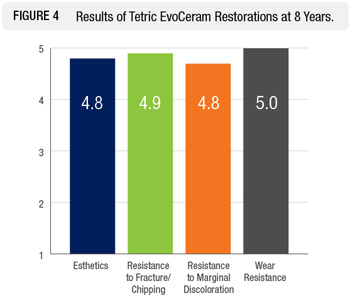
Wear Resistance
98% of the restorations showed no evidence of wear and received and excellent rating, whereas 1.5% of the restorations received a good or very good rating (Figure 4). Only 0.5% of the restorations required replacement because of excessive wear.
Conclusions
Tetric EvoCeram has excellent handling characteristics. It is non-slumping, not sticky, contours well, and is easy to finish and polish. This eight-year evaluation of 637 restorations demonstrated that Tetric EvoCeram had superior performance in esthetics, resistance to fracture/chipping, resistance to marginal discoloration, and wear resistance. Tetric EvoCeram received a 97% clinical performance rating.
Ask Dr. Farah
Dr. John Farah has watched the evolution of many dental materials from a clinical and laboratory perspective since 1965. We have asked him to share his experiences in hopes that we can gain a greater appreciation for the changes that have occurred and understand the trends we are seeing today.
| What changes in composites do you feel have most dramatically impacted dentistry over the past 30 years? |
| Modern composites definitely have better handling, resulting in easier placement. I prefer composites that are somewhat condensable – more viscous and more highly fi lled – resulting in easier contouring and development of anatomy. I want a composite that is easy to shape and will maintain its form but not drag. Good examples are Tetric EvoCeram (Ivoclar Vivadent) and Aura [SDI (North America) Inc.]. Modern composites also have better wear characteristics and excellent shade stability. I just observed a Tetric EvoCeram composite where there was no detectable wear and the shade was perfect after 10 years. Because of the very small size of filler particles, modern composites polish well and retain their gloss over time too. The strength properties are outstanding; it is rare for a clinician to see an actual fracture of a composite. |

